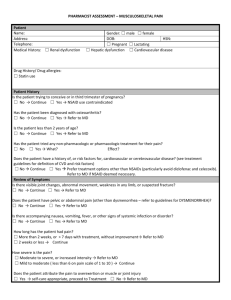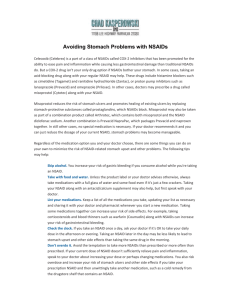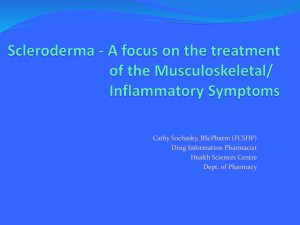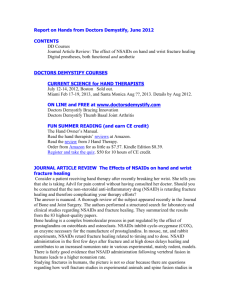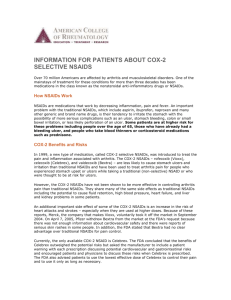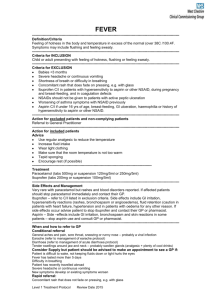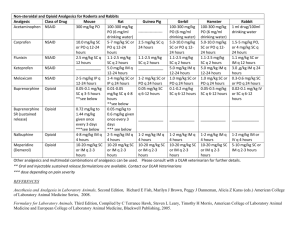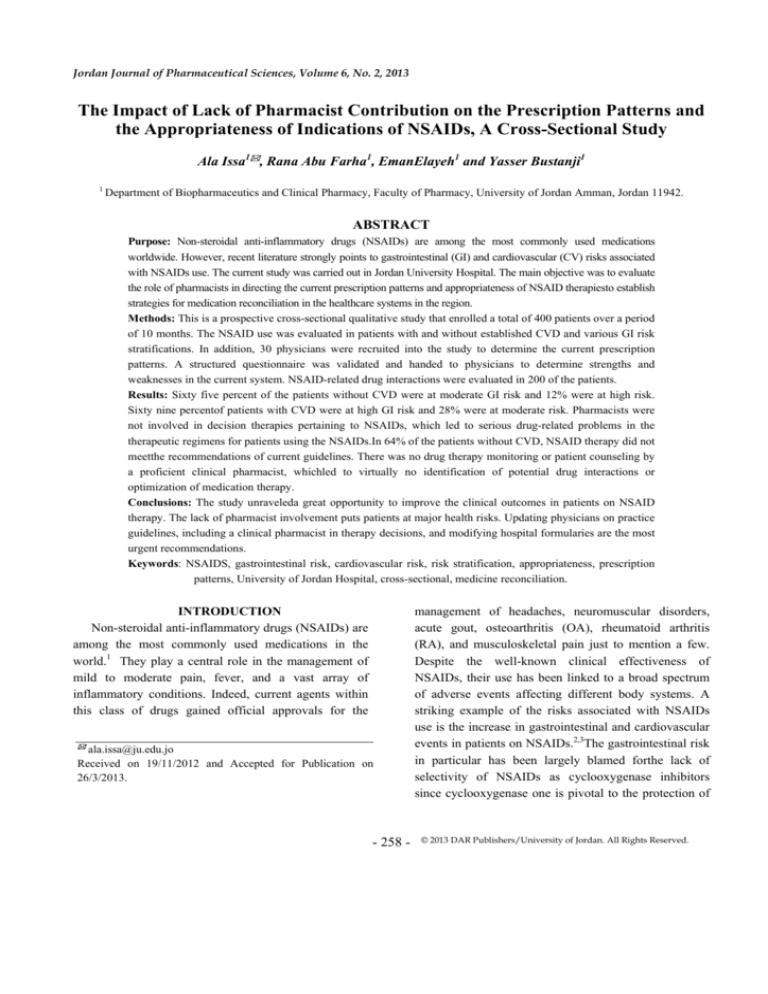
Jordan Journal of Pharmaceutical Sciences, Volume 6, No. 2, 2013
The Impact of Lack of Pharmacist Contribution on the Prescription Patterns and
the Appropriateness of Indications of NSAIDs, A Cross-Sectional Study
Ala Issa1, Rana Abu Farha1, EmanElayeh1 and Yasser Bustanji1
1
Department of Biopharmaceutics and Clinical Pharmacy, Faculty of Pharmacy, University of Jordan Amman, Jordan 11942.
ABSTRACT
Purpose: Non-steroidal anti-inflammatory drugs (NSAIDs) are among the most commonly used medications
worldwide. However, recent literature strongly points to gastrointestinal (GI) and cardiovascular (CV) risks associated
with NSAIDs use. The current study was carried out in Jordan University Hospital. The main objective was to evaluate
the role of pharmacists in directing the current prescription patterns and appropriateness of NSAID therapiesto establish
strategies for medication reconciliation in the healthcare systems in the region.
Methods: This is a prospective cross-sectional qualitative study that enrolled a total of 400 patients over a period
of 10 months. The NSAID use was evaluated in patients with and without established CVD and various GI risk
stratifications. In addition, 30 physicians were recruited into the study to determine the current prescription
patterns. A structured questionnaire was validated and handed to physicians to determine strengths and
weaknesses in the current system. NSAID-related drug interactions were evaluated in 200 of the patients.
Results: Sixty five percent of the patients without CVD were at moderate GI risk and 12% were at high risk.
Sixty nine percentof patients with CVD were at high GI risk and 28% were at moderate risk. Pharmacists were
not involved in decision therapies pertaining to NSAIDs, which led to serious drug-related problems in the
therapeutic regimens for patients using the NSAIDs.In 64% of the patients without CVD, NSAID therapy did not
meetthe recommendations of current guidelines. There was no drug therapy monitoring or patient counseling by
a proficient clinical pharmacist, whichled to virtually no identification of potential drug interactions or
optimization of medication therapy.
Conclusions: The study unraveleda great opportunity to improve the clinical outcomes in patients on NSAID
therapy. The lack of pharmacist involvement puts patients at major health risks. Updating physicians on practice
guidelines, including a clinical pharmacist in therapy decisions, and modifying hospital formularies are the most
urgent recommendations.
Keywords: NSAIDS, gastrointestinal risk, cardiovascular risk, risk stratification, appropriateness, prescription
patterns, University of Jordan Hospital, cross-sectional, medicine reconciliation.
INTRODUCTION
Non-steroidal anti-inflammatory drugs (NSAIDs) are
among the most commonly used medications in the
world.1 They play a central role in the management of
mild to moderate pain, fever, and a vast array of
inflammatory conditions. Indeed, current agents within
this class of drugs gained official approvals for the
ala.issa@ju.edu.jo
Received on 19/11/2012 and Accepted for Publication on
26/3/2013.
- 258 -
management of headaches, neuromuscular disorders,
acute gout, osteoarthritis (OA), rheumatoid arthritis
(RA), and musculoskeletal pain just to mention a few.
Despite the well-known clinical effectiveness of
NSAIDs, their use has been linked to a broad spectrum
of adverse events affecting different body systems. A
striking example of the risks associated with NSAIDs
use is the increase in gastrointestinal and cardiovascular
events in patients on NSAIDs.2,3The gastrointestinal risk
in particular has been largely blamed forthe lack of
selectivity of NSAIDs as cyclooxygenase inhibitors
since cyclooxygenase one is pivotal to the protection of
© 2013 DAR Publishers/University of Jordan. All Rights Reserved.
Jordan Journal of Pharmaceutical Sciences, Volume 6, No. 2, 2013
is to provide insights and rationalized suggestions that
willhelp improve the health care system in Jordan and
similar systems in the region.
the gastrointestinal mucosa.Hence, a subclass of
NSAIDs with more cyclooxygenase-2 (COX-2)
selectivity
was
introduced
in
the
early
1990s.4Unfortunately, patients on the more selective
agents suffered from increased cardiovascular(CV) risks
and required thorough patientassessment prior to their
use and closer monitoring during the therapy.5-8In fact,
the Food and Drug Administration (FDA), the European
Medicines Agency (EMA), and the American College of
Gastroenterology (ACG)agree that the eligibility for
NSAID therapy must be decided only after a thorough
assessment of GI and CV risk factors in the individual
patient.9-11
It is currently recommended thatnon-selective
NSAIDs should be co-prescribed with a gastroprotective agent in patients with a moderate GI risk.1113
A COX-2-selective agent plus a proton pump inhibitor
(PPI) is recommended in those with the highest GI risk,
and all NSAIDs should be avoided in patients who have
high GI and CV risks.10-13Interestingly, the FDA clearly
states that the CV risk is associated with all NSAIDs,
excluding aspirin.9
The main objective of this study was to evaluate the
current prescription patterns and appropriateness of
NSAID therapies in Jordan in compliance with current
recommendations issued by the ACG.11In addition, the
prevalence of NSAID-related GI risk factors in patients,
with and without established cardiovascular disease,
CVD was determined.The current study provides a grim
glimpse of the consequences of neutralizing the role of
the clinical pharmacist in patient therapy. On the other
hand, we hope that the results of the study willbe a first
step in establishing a better health care system in Jordan
that incorporates pharmacist-run medication therapy
management (MTM) services. Further, to our
knowledge, this is the first study in Jordan to be
conducted in accordance with the principles of medicine
reconciliation. Unlike previous studies that merely
reported prescription patterns and the prevalence of drug
therapy in Jordan and the Middle East, the current study
points to weaknesses and strengths of NSAID therapy in
one of the busiest hospitals in Jordan. Our ultimate goal
METHODOLOGY
Study Design
The current study is a prospective cross-sectional
qualitative study that was carried out on patients treated
in Jordan University Hospital (JUH).The patients
included in the study were those who received
prescriptions for NSAIDs as a part of the pharmacologic
management of their underlying diseases. The study
design encompassed three parallel arms.The first arm
assessed the prescription patterns and appropriateness of
NSAID therapy in patients without established
cardiovascular disease who had various GI risks. The
second arm assessed the prescription patterns and
appropriateness of NSAID therapy in patients with
established CVD.
The third arm determined the
currentprotocols and practices used to identify and
manage NSAID-related drug interactions in patients
receiving low daily doses of aspirin (100-325 mg). The
aspirin intake was for primary or secondary prevention
of myocardial infarction or other major cardiac events in
patients with diagnosed ischemic heart diseases. A total
of 400 patients and 30 physicians were recruited into the
study over a period of ten months. One hundred patients
were recruited for each of the first two arms of the study
and two hundred patients were recruited for the third
arm. Patients were interviewed,their medical records
reviewed, and patient data forms were filled according to
the study protocol. The protocol was approved by the
institutional review board (IRB) of the Jordan University
and Jordan University Hospital. The stratification of GI
risk in patients on NSAIDs was according to the
American College of Gastroenterology (ACG)2009
guidelines.11After assessing the GI risk in NSAID users,
we assessed the appropriateness of the selected NSAIDs
and the rationale for any gastro-protective agentsthat
were administered to the patient or newly prescribed by
the treating physicians.The study was carried out in JUH
in Ammanbetween July 2011 and April 2012.
- 259 -
The Impact of Lack…
AlaIssa et al
Data Collection
The inclusion and exclusion criteria were detailed in
the study protocol and approved by the IRB as
mentioned above. During the time of study, all patients
eligible for inclusion were required to provide a verbal
informed consent in accordance with the declaration of
Helsinki.14Patient
demographic
data,
clinical
characteristics, medical history, and current medications,
including prescribed NSAIDs and gastro-protective
agents, were all gathered and documented.
For the first part of the study (patients without
established CVD), patients were included if they met the
following criteria: 1)Intake of a prescribed daily NSAID
for less than three months at the time of recruitment, 2)
Low, moderate or high GI risk according to ACG 2009
guidelines, 3) Patients with or without acid-suppressive
therapies, and 4) Patients treated as either in patients or
out patients at JUH.
Patients were excluded if they have established CVD
or diabetes, Framingham score > 20%, and if they were
using NSAIDs on a daily basis for more than three
months or if NSAIDs were used on anas needed basis.
For the second arm, patients were included if they
met the following criteria: 1) Intake of a prescribed daily
NSAID for less than three months at the time of
recruitment, 2) Established diagnosis of cardiovascular
disease (Angina, MI, CAD, CHF, stroke, arrhythmia, or
PAD), 3) Daily, intermittent or no use of low dose
aspirin (100-325 mg), 4) Low, moderate or high GI risk
according to ACG 2009 guidelines, and 5) Patients with
or without acid-suppressive therapies.Patients with
diabetes, active bleeding, or critically ill (ICU patients)
were excluded.
For the third arm, patients receiving daily aspirin for
the primary and secondary prevention of CV disease
(100-325 mg) and taking two or more medications
during a hospital stay were included. Diabetic patients
were excluded.
For all arms of the study, the inclusion criteria
allowed only males and females over 18 years to
participate.
- 260 -
Gastrointestinal Risk Stratification
The stratification of the patient’s gastrointestinal risk
was according to ACG guidelines.11Information
regarding CV history including any previous history of
thrombotic events, i.e. myocardial infarction, angina,
stroke, heart failure and peripheral arteriopathy, was
collected. These diagnoses were confirmed by reviewing
the patient’s medical record.
Patients were classified into three GI risk categories
(low, moderate and high). In summary, patients were
considered to be at low GI risk if they did not have any
of the risk factors. Patients at moderate GI risk had one
or two risk factors: Age >65 years, concomitant use of
low dose aspirin, anticoagulant, or corticosteroid, history
of uncomplicated ulcer, and use of two NSAIDS or high
dose NSAID. Patients at high GI risk had a history of GI
ulcer complication (GI bleeding history or perforation),
or the presence of three of the risk factors above.
After assessing the GI risk for NSAID users, we
assessed the appropriateness of the selected NSAID and
the use of gastro-protective agents as recommended by
the 2009 ACG practice guidelines for the prevention of
NSAID-induced ulcers.11
Identification of Potential Drug – Drug
Interaction(pDDIs)
Two hundred patients were included in this arm of
the study. Patients were interviewed and their medical
records were reviewed to collect information regarding
medical therapies that the patients were receiving.Patient
length of hospital stay and the number of admissions
were also reviewed.
Identification of pDDIs was done using an online
interactive analysis program:Lexi-interact online.15This
program gives monographic information about
interactions and severity of the outcome; it also gives
information about the onset of interactions and reliability
rating. Potential drug interactions were classified
according to the severity of interactions into minor,
moderate, and major.
Statistical Analysis
The data were analyzed using the Statistical Package
for Social Science (SPSS), version 17. Descriptive
Jordan Journal of Pharmaceutical Sciences, Volume 6, No. 2, 2013
an attribute that is present in the population, and q is 1-p.
The value for Z is found in statistical tables which contain
the area under the normal curve:
N = (0.5) (0.5) (10.5)/ (0.027) = 98 individuals in
each group.
statistics were used for the purpose of obtaining
frequencies and percentages of demographics,clinical
characteristics, GI risk factors, CV history,
andpharmacological treatments.The means and standard
deviations were calculated forcontinuous variables and
percentages for qualitativevariables. Statistical analyses
using Pearson and Spearman correlations were
performed to find out the statistical significance between
the number of pDDIs and different factors.
For calculating the minimum sample size and
assuming a Confidence Interval(CI) of 95% and a
Power(P) of 90%, the following equation was used.
N = pqz²/δ²
Where N is the minimum sample size, Z2 is the abscissa
of the normal curve that cuts off an area at the tails (1 equals the desired confidence level, e.g., 95%), e is the
desired level of precision, p is the estimated proportion of
RESULTS
Demographic Characteristics
The demographic details of the patients included in
the study are shown in table 1.In the first arm of the
study (patients with no CVD), women accounted for
67% of the patients and the average age for the group
was 43.9 years. Twenty percent of the patients were
aged over 65 years in this group. The second arm of the
study (patients with established CVD) included also one
hundred patients. Most patients were older than 65 years
(73%) and females accounted for 64 % of the patients.
Table 1. Demographic characteristics of patients included in the study
Demographic characteristic Patients with no established CVD (n=100) Patients with established CVD (n=100)
Age (years) mean ±SD
43.94 ± 17.7
66.79±10.36
Less than 65 years. N(%)
80 (80%)
27 (27%)
Above65 years. N(%)
20 (20%)
73 (73%)
Female. N(%)
67 (67%)
64 (64%)
BMI, kg/m2
Underweight
Normal
Overweight
Obese
Smokers. N(%)
Alcohol drinking. N(%)
9 (9%)
20 (20%)
30 (30%)
41 (41%)
23 (23%)
8 (8%)
0 (0%)
27 (27%)
43 (43%)
30 (30%)
2 (2%)
0 (0%)
(33%) followed by a history of myocardial infarction
(27%) and heart failure (15%).
Percentages of NSAIDs and COX-2 inhibitors
prescribed for patients are summarized in table 2. For
patients with no established CVD, non-selective
NSAIDs accounted for around 98% of prescriptions. Of
these, diclofenac sodium was the most commonly
prescribed NSAID (89%) followed by ibuprofen (5%).
Prescription of COX-2 selective agents was very low
(2%). A similar prescription pattern was seen in patients
Clinical Characteristics
For patients with no established CVD, rheumatoid
arthritis was the most common indication for prescribing
an NSAID (33%) followed by osteoarthritis (26%). On
the other hand, in patients with established CVD,the
most common indication for prescribing an NSAIDwas
osteoarthritis (44%), followed by rheumatoid arthritis
(18%).
The most common cardiovascular diseases among
patients in the second arm of the study were angina
- 261 -
The Impact of Lack…
AlaIssa et al
with established CVD.The number of prescriptions for
non-selective NSAIDs far exceeded the prescriptions for
selective COX-2 inhibitors (94% vs. 6%).In this group,
diclofenac sodium was the most commonly prescribed
non-selective NSAID (82%), followed by nimesulide
(even though it is considered a selective COX-2
inhibitor in many countries, it is listed in JUH formulary
as a non-selective agent) and ibuprofen (9%and 3%,
respectively). Celecoxib was the only selective COX-2
inhibitor prescribed (6%) in this group of patients.
Gastrointestinal Risk
The two most prevalent risk factors in patients with
no established CVD were concomitant use of
anticoagulants (51%)followed by concomitant use of
corticosteroids (28%), while the least common risk
factor was the use of a high doseNSAID. In patients
with established CVD, the most common GI risk
factorswere concomitant use of an anticoagulant (75%)
followed by age above 65 years (73%), and concomitant
use of prednisolone (61%).
Taking into account the previous risk factors,
patients were classified into three levels of GI risk: low,
moderate and high.For patients with no established
CVD, the highest percentage was for those with
moderate GI risk (65%), followed by low GI risk group
(23%) and high GI risk group (12 %). On the other
hand, most patients with established CVD were
identified as having high GI risk (69%). Moderate and
low GI risk groups accounted for 28 and 3 %,
respectively.
The two gastro-protective agents that were
prescribed to patients in JUHwere famotidine 40 mg/day
and omeprazole 20 mg/day. Table 3 sumarizes the types
of gastro-protective agents used according to different
GI risk levels.
Table 2. Types of prescriptions according to GI risk group in patients with or without established CVD
Patients without CVD
Type of treatment
Low GI risk N (%)* Moderate GI risk N (%)* High GI risk N (%)*
(n=23)
(n=65)
(n=12)
NSAID alone
23 (100%)
48 (73.8%)
3 (25%)
COX-2 inhibitor alone
0 (0%)
1 (1.5%)
0 (0%)
NSAID + PPI
0 (0%)
11 (16.9%)
8 (66.7%)
NSAID +H2RA
0 (0%)
5 (7.7%)
0 (0%)
COX-2 inhibitor + PPI
0 (0%)
0 (0%)
1 (8.3%)
Patients with established CVD
Type of treatment
Low GI risk N (%)* Moderate GI risk N (%)* High GI risk N (%)*
(n=3)
(n=28)
(n=69)
NSAID alone
0 (0%)
10 (35.7%)
14 (20.3%)
COX-2 inhibitor alone
0 (0%)
0 (0%)
2 (2.9%)
NSAID + PPI
3 (100%)
18 (64.3%)
43 (62.3%)
NSAID +H2RA
0 (0%)
0 (0%)
6 (8.7%)
COX-2 inhibitor + PPI
0 (0%)
0 (0%)
4 (5.8%)
Naproxen +PPI
0 (0%)
0 (0%)
0 (0%)
PPI: proton pump inhibitor, H2RA: H2 receptor antagonist
*Percentage among each risk group.
- 262 -
Jordan Journal of Pharmaceutical Sciences, Volume 6, No. 2, 2013
Table 3. Types of gastro-protective agents used acoording to different GI risk levels.
Patients Without CVD
Drug therapy
Famotidine
Omeprazole
Drug therapy
Famotidine
Omeprazole
Number of prescriptions
5
20
Number of prescription
6
68
Low GI risk (n=23)
Moderate GI risk (n= 65)
0
5
0
11
Patient with CVD
Low GI risk (n=3) Moderate GI risk (n= 28)
0
0
3
18
Finally, after classifying patients to different GI risk
levels, we assessed the appropriateness of NSAID
selection and the appropriateness of using gastroprotective agents according to different GI risk levels.
In patients without established CVD, all patients at
low GI risk were appropriately treated with nonselective
NSAIDs alone. Unfortunately, only 18.4 % of the
patients with moderate GI risk were appropriately
treated with a COX-2 inhibitor alone or an NSAID plus
a gastro-protective agent (PPI) as recommended by the
ACG. The remainder of the patients within this GI risk
received NSAID alone or NSAID plus H2RA which is
considered ineffective in preventing NSAID induced
ulcers according to ACG 2009 guidelines. For patients
with high GI risk, only8.3 % of the patients received the
correct treatment of COX-2 plus PPI.The majority of
high risk patients were treated with a nonselective
NSAID and a PPI. In summary, only 36 patients
(36%)were receiving the appropriate treatment of
NSAIDs according to ACG 2009 guidelines, while 64%
of the patients were inappropriately treated.
On the other hand, none of the patients with CVD (at
low, moderate or high GI risk) received the appropriate
treatment according to ACG recommendations.
High GI risk(n=12)
0
9
High GI risk(n=69)
6
47
Evaluation of NSAID-related Drug Interactions
The total number of potential drug-drug interactions
(pDDIs) for the 200 patients was 704 interactions. The
mean number of pDDIs for each patient was 3.81
interactions. The pDDIs were classified based on the
severity of the interaction into major, moderate, and
minor interactions. The majority of interactions were of
moderate severity(84.5%). Major and minor drug
interactions accounted for 12.1% and 3.4 %,
respectively.Among the 704 pDDIs, 374 interactions
involved aspirin therapy. The most common drug pairs
were aspirin-enoxaparin (103 interactions accounting for
14.6% of all interactions).
Statistical analysis by the Pearson correlation
indicated a strong relationship between the number of
drugs prescribed for each patient and number of pDDIs
(r=0.505). There was a weak relationship between the
number of pDDIs and the number of admissions in the
following three months(Spearman correlation =0.144).
When applying the Spearman correlation, there was no
significant relationship between the number of pDDIs
and the length of hospital stay (r= 0.095). Also there was
no correlation between the number of pDDIs and the
number of hospital admissions for a period of six
months. (Spearman correlation r= 0.045).
- 263 -
The Impact of Lack…
AlaIssa et al
Table 4: Frequency and severity of the most common potential drug-drug interactions involving aspirin in the
studied population.
Pair of drugs
Frequency (percentage %)* Interaction Severity
aspirin/enoxaparin
103(14.6)
Moderate
aspirin/furosemide
72(10.2)
Moderate
aspirin/clopidogrel
61 (8.7)
Moderate
aspirin/warfarin
24 (3.4)
Major
aspirin/calcium carbonate
22 (3.1)
Minor
aspirin/levofloxacin
22 (3.1)
Moderate
aspirin/hydrocortisone
18 (2.6)
Moderate
aspirin/enalapril
16 (2.3)
Moderate
aspirin/prednisolone
15 (2.1)
Moderate
aspirin/heparin
11 (1.6)
Major
aspirin/glimepiride
10 (1.4)
Moderate
*Percentage from the total number of drug- drug interactions (704)
DISCUSSION
NSAIDs (non-steroidal anti-inflammatory drugs)
comprise a cornerstone in the management of a vast
plethora of inflammatory and painful conditions.
Unfortunately, NSAIDs’ use is not void of serious
adverse events. These include gastrointestinal ulceration
and bleeding, hepatic and renal toxicities, and an
increase in thromboembolic events.16-20Using NSAIDs
safely requires striking a balance between cardiovascular
safety and gastrointestinal safety. NSAIDs that are the
safest from a cardiovascular standpoint tend to have
higher gastrointestinal toxicity and vice versa, but the
risk rankings are not absolute and are based on
epidemiologic data.
The ACG recommends naproxen as the NSAID of
choice for patients with low or moderate gastrointestinal
risk but high cardiovascular risk. These patients,
however, will also require a proton pump inhibitor or
misoprostol. Finally, patients with high risk of both
gastrointestinal and cardiovascular risk should not
receive an NSAID,whether COX-2 selective or
nonselective.11
The study was conductedat Jordan University
Hospital (JUH) over a period of 10 months. JUH is one
of the busiest hospitals in Amman and the oldest
educational hospital in Jordan. In the first part of the
- 264 -
study, we looked at the prevalence of GI and CV risk
factors in the study population. We excluded all diabetic
patients from the study since diabetes is considered a
coronary heart disease (CHD) equivalent that may
influence the cardiovascular risk stratification.
In patients with established CVD, the most common
GI risk factors were concomitant use of
an
anticoagulant (75%) followed by age above 65 years
(73%) and then concomitant use of prednisolone (61%).
These results are comparable to those reported by a
previous studies in which 76.1% of the patients had an
age as the most common GI risk factor for NSAID
induced ulcer.21Unfortunately, none of the patients
werecategorized into different GI risks prior to NSAID
therapies by the treating medical team. The assessment
of the GI risk was quite subjective.When looking at the
individualized treatments for the patients, it was found
that that 81.5% of the patients at moderate GI risk and
no established CVD were inappropriately treated with
nonselective NSAIDs alone or NSIAD plus H2RA (73.8
+ 7.7% for NSAID alone or NSAID with H2RA,
respectively). Likewise, 91.7% of the patients with high
GI risk were inappropriately treated with either
nonselective NSAID alone or a non-selective NSAID
and a PPI.
As recommended by ACG 2009 guidelines, patients
Jordan Journal of Pharmaceutical Sciences, Volume 6, No. 2, 2013
with established CVD and low or moderate GI risk
should be treated with naproxen and a gastro-protective
agent like PPI or misoprostol. None of the patients with
established CVD who were at low or moderate GI risk
wereprescribed naproxen. For patients with CVD and
high GI risk, NSAIDs including COX-2 inhibitors
should be avoided and an alternative therapy including
tramadol, narcotics, non-pharmacologic therapies,
topical therapies, and surgeries, if necessary, should be
recommended. None of the patients who were at high GI
risk wereprescribed an alternative therapy. In other
words, all patients with established CVD were
inappropriately treated. The choice of an NSAID was
wrong for CVD patients with low and moderate GI risk
as none of the patients wereprescribed naproxen. The
use of gastro-protective agents was prescribed only for
64.3% of patients with moderate GI risk. When numbers
werecombined, only 21% of the total population of
patients with established CVD at low and moderate GI
risk was prescribed a gastro-protective agent for
prevention of NSAID induced GI toxicity. Hence, the
need for the active involvement of a clinical pharmacist
in selecting the appropriate NSAID and modification of
the risks is undeniable.
Interestingly, in a Spanish population of
osteoarthritis patients, more than 90% of patients were at
increased GI risk and 60.3% of them were at high risk
for cardiovascular events. When both the GI and CV
risks were combined, 51% of the study population was
prescribed drugs that were either not recommended or
contraindicated.23The latter finding shows that NSAIDs
therapies, in particular, mandate the involvement of a
clinical pharmacist regardless of the geographic or
ethnic differences between patients.
Several studies have shown that the use of nonselective NSAIDs is associated with an increased risk of
cardiovascular events.5,8,24-28 Despite the fact that
absolute risk is low, evidence showed that higher doses
or frequency of use increases the risk more.5,8Naproxen
is considered the safest among NSAIDs with respect to
cardiovascular risk.24A recent meta-analysis (including
31 trials of116,429 patients with average follow up of
one year) evaluated the cardiovascular effects of three
non-selective NSAIDs (naproxen, ibuprofen, and
diclofenac) and four COX-2 selective NSAIDs
(celecoxib, etoricoxib, rofecoxib, and lumiracoxib). It
has shown that ibuprofen was associated with the
highest risk of stroke (3.36, 1.00to 11.6), followed by
diclofenac (2.86, 1.09 to 8.36).The highest risk of
myocardial infarction was associated with rofecoxib
(rate ratio 2.12, 95% credibility interval 1.26 to 3.56),
followed by lumiracoxib (2.00, 0.71 to 6.21). Etoricoxib
(4.07, 1.23 to 15.7) and diclofenac (3.98, 1.48 to 12.7)
were associated with the highest risk of cardiovascular
death.24
Non-selective NSAIDs were the most commonly
prescribed NSAIDs among JUH patients with CVD
(94%). The CV risk of the individual agent did not have
any impact on the drug selection. In fact, 89% of the
patients with established CVD were prescribed
diclofenac sodium. This NSAID has been shown in a
recent study to increase the risk for cardiovascular
mortality after a single day of treatment.30These results
may reflect the inappropriate knowledge of physicians of
the risks associated with NSAIDs and the lack of proper
assessment of both GI and CV risk in patients prescribed
NSAIDs.
On the other hand, only 6% of the patients were
receiving celecoxib, which was the only COX-2
selective NSAID available in JUH formulary. Patients
with established CVD who were prescribed celecoxib in
this study had high GI risks as well. Hence, it seems that
prescribing physicians took into consideration the GI
risk but not the CV risk in selecting an NSAID to treat
their patients. Celecoxib would be inappropriate for
patients with high GI and high CV risks.11
The cardiovascular effects of celecoxib are seen in
the recent meta-analysis mentioned above.24The risk of
myocardial infarction (MI) with celecoxib compared
with a placebo (RR, 1.35, 95% CI, 0.71-2.72) was lower
than that for rofecoxib (RR 2.12, 95% CI 1.26-3.56) or
ibuprofen (RR 1.61, 95% CI 0.50-5.77), but greater than
naproxen (RR 0.82, 95% CI 0.37-1.67), which had the
most favorable cardiovascular risk profile.26
- 265 -
The Impact of Lack…
AlaIssa et al
Identification and management of NSAID-related
drug interactions were selected in this study to determine
points of strengths and weaknesses in the current
healthcare system in Jordan.
Finally, the current study is the first study in Jordan
to evaluate the prescription patterns and appropriateness
of NSAID therapy for the purpose of establishing
strategies for medication reconciliation. The latter is a
relatively new concept in Jordan and the region since the
focus of patient treatment has been primarily rotating
around physician competency and skills. In fact, there is
currently no defined responsibility or active involvement
of clinical pharmacists in patient treatments in Jordan.
This could be largely attributed to poor communication
and trust issues between physicians and their pharmacist
colleagues. Unfortunately, the same grim relation
between pharmacists and physicians is observed in most
of the Middle East and North African countries. To
complicate things further, all NSAIDs can be purchased
without a prescription in Jordan and neighboring
countries. Hence, an established role for community and
clinical pharmacists in medication selection and
monitoring is pivotal to improve the clinical outcomes
for patients. Medication reconciliation strategies are
essential to establish a better role for the pharmacist and
optimize patient therapies.
REFERENCES
atherothrombosis? Metaanalysis of randomisedtrials.
BMJ.2006; 332:1302-1308.
(6) García Rodríguez L.A. and González-Pérez A. Longterm use of non-steroidal anti-inflammatory drugs and
the risk of myocardial infarction in the general
population. BMC Med. 2005; 3:17.
(7) Hernández-Díaz S., Varas-Lorenzo C. and García
Rodríguez L.A. Non-steroidal anti-inflammatory drugs
and the risk of acute myocardial infarction.Basic
ClinPharmacolToxicol.2006; 98:266-274.
(8) McGettigan P. and Henry D. Cardiovascular risk and
inhibition of cyclooxygenase: a systematic review of
the observational studies of selective and nonselective
inhibitors of cyclooxygenase 2. JAMA.2006; 296:16331644.
(9) FDA. Safety Alerts for Human Medical Products.
COX-2 Selective and Non-Selective Non-Steroidal
Anti-Inflammatory
Drugs
NSAIDs.2005
[http://www.fda.gov/Drugs/DrugSafety/
PostmarketDrugSafetyInformationforPatientsandProvid
ers/ucm150314.htm].
(10) EMEA. EMEA Press Release: European Medicines
Agency Review Concludes Positive Benefit-risk
(1) PauloseR., Hirsch R., Dillon C. and Gu Q.Frequent
monthly use of selected non-prescription and
prescription non-narcotic analgesics among U.S.
adults.Pharmacoepidemiology and Drug Safety.2005;
14 (4): 257-266.
(2) Rainsford KD. Profile and mechanisms of
gastrointestinal and other side effects of non-steroidal
anti-inflammatory drugs (NSAIDs).Am J Med. 1999;
13; 107(6A):27S-35S.
(3) Holmgren H.and Schneede J. NSAID can increase
the risk of cardiovascular incidents. The risk increase is
usually connected to dosage and the length of treatment.
Lakartidningen. 2012; 25-31;109 (4):164.
(4) Rostom A., Muir K., Dubé C., Jolicoeur E., BoucherM.,
Joyce J., Tugwell P. and Wells G.W. Gastrointestinal
safety of cyclooxygenase-2 inhibitors: a Cochrane
Collaboration
systematic
review.
ClinGastroenterolHepatol. 2007; 5:818-828.
(5) Kearney P.M., Baigent C., Godwin J., Halls H.,
Emberson J.R. andPatrono C. Do selective cyclooxygenase-2 inhibitors and traditional non-steroidal
anti-inflammatory drugs increase the risk of
- 266 -
CONCLUSIONS
This study provides valuable information on the high
prevalence of GI risk factors in patients who receive
NSAID therapy in Jordan. It shows that adherence to
guidelines for safe prescription of NSAIDs was
poor.The study unravels a great opportunity to improve
the clinical outcomes in patients on NSAID therapy.
Updating physicians on practice guidelines, including a
clinical pharmacist in therapy decisions, and modifying
hospital
formularies
are
the
most
urgent
recommendations to improve the healthcare systems in
the region.
Jordan Journal of Pharmaceutical Sciences, Volume 6, No. 2, 2013
Balance for Non-selective NSAIDs. CHMP 24 October
2006.
[http://www.emea.
europa.eu/pdfs/
human/press/pr/
41313606.pdf],
Doc.
Ref.
EMEA/413136/2006.
(11) Lanza F.L., Chan F.K. andQuigley E.M. (). Practice
Parameters Committee of the American College of
Gastroenterology Guidelines for prevention of NSAIDrelated ulcer complications. Am J Gastroenterol. 2009;
104(3):728-38.
(12) Chan F.K.L., Abraham N.S., Scheiman J.M. andLaineL.
Management of patients on non-steroidal antiinflammatory
drugs:
A
clinical
practice
recommendation from the First International Working
Party on gastrointestinal and cardiovascular effects of
non-steroidal anti-inflammatory drugs and anti-platelet
agents. Am J Gastroenterol.2008; 103:2908-2918.
(13) Burmester G., Lanas A., Biasucci L., Hermann M.,
Lohmander S., Olivieri I., Scarpignato C., Smolen J.
andStoevelaar H.On behalf of the European Expert
Panel on the Appropriate Use of NSAID., The
appropriate use of non-steroidal anti-inflammatory
drugs in rheumatic disease: opinions of a
multidisciplinary European expert panel. Ann Rheum
Dis. 2011; 70(5):818-822
(14) Declaration of Helsinki. World Medical Association.
1964.
Available
from:
http://www.wma.net/
e/ethicsunit/helsinki.htm
(15) Lexi-Interact™ Online, Lexi-Comp's Comprehensive
Drug-to-Drug, Drug-to-Herb and Herb-to-Herb
Interaction Analysis Program, 1978-2012 Lexi-Comp
Inc.
retrieved
fromhttp://www.uptodate.
com.ezlibrary.ju.edu.jo/crlsql/interact/frameset.jsp
(16) Bhatt D.L., Scheiman J., Abraham N.S., et al.
ACCF/ACG/AHA
2008
expert
consensus
documentation reducing the gastrointestinal risks of
anti-platelettherapy and NSAID use: a report of the
AmericanCollege of Cardiology Foundation Task Force
onClinical
Expert
Consensus
Documents.
Circulation;2008; 118:1894-909.
(17) Masso Gonzalez E.L., Patrignani P., Tacconelli S. and
Garcia Rodriguez L.A. Variability amongnonsteroidalanti-inflammatory
drugs
in
risk
of
uppergastrointestinal bleeding.Arthritis Rheum.2010;
62:1592-601.
(18) Hernandez-Diaz S. and Rodriguez L.A. Incidence
ofserious upper gastrointestinal bleeding/perforationin
the general population: review of epidemiologicstudies.
J ClinEpidemiol.2002; 55:157-63.
(19) Bergamo R.R., Cominelli F., Kopple J.D. andZipser
R.D. Comparative acute effects of aspirin,
diflunisal,ibuprofen and indomethacin on renal function
inhealthy man.Am J Nephrol.1989; 9:460-3.
(20) Cook M.E., Wallin J.D., Thakur V.D., et al.
Comparativeeffects of nabumetone, sulindac, and
ibuprofen onrenal function.J Rheumatol.1997; 24:1137-44.
(21) Lanas
A., Tornero
J.
and Zamorano
J.L.
Assessment of gastrointestinal and cardiovascular risk i
n patients with osteoarthritis who require NSAIDs: the
LOGICA study, Ann Rheum Dis.2010; 69(8):1453-8.
(22) Antman E.M., Bennett J.S., Daugherty A., Furberg C.,
Roberts H. andTaubert K.A. American Heart
Association, Use of non-steroidalanti-inflammatory
drugs: an update for clinicians: a scientific statement
from the American Heart Association.Circulation.
2007; 115(12):1634.
(23) Lanas A., Garcia-Tell G., Armada B. and Oteo-Alvaro
A. Prescription patterns and appropriateness of NSAID
therapy according togastrointestinal risk and cardiovasc
ular history in patients with diagnoses ofosteoarthritis.
BMC Med. 2011; Apr 14;9:38.
(24) Trelle S., Reichenbach S., Wandel S., Hildebrand P.,
Tschannen B., Villiger P.M., Egger M. andJüni P.
Cardiovascular
safety
of
non-steroidal
antiinflammatory drugs: network meta-analysis., BMJ.
2011; 342:c7086.
(25) Hippisley-Cox J. andCoupland C. Risk of myocardial
infarction in patients taking cyclo-oxygenase-2
inhibitors or conventional non-steroidal antiinflammatory drugs: population based nested casecontrol analysis, BMJ. 2005; 330(7504):1366.
(26) Graham D.J., Campen D., Hui R., Spence M.,
Cheetham C., Levy G., Shoor S. and Ray W.A. Risk of
acute myocardial infarction and sudden cardiac death in
patients treated with cyclo-oxygenase 2 selective and
non-selective non-steroidal anti-inflammatory drugs:
nested case-control study.Lancet.2005; 365(9458):475.
(27) Johnsen S.P., Larsson H., Tarone R.E., McLaughlin
J.K., Nørgård B., Friis S. andSørensen H.T. Risk of
hospitalization for myocardial infarction among users of
rofecoxib, celecoxib, and other NSAIDs: a population-
- 267 -
The Impact of Lack…
AlaIssa et al
based case-control study. Arch Intern Med. 2005;
165(9):978.
(28) Helin-Salmivaara A., Virtanen A., Vesalainen R.,
Grönroos J.M., Klaukka T., Idänpään-HeikkiläJ.E.
andHuupponen R. NSAID use and the risk of
hospitalization for first myocardial infarction in the
general population: a nationwide case-control study
from Finland. Eur Heart J. 2006; 27(14):1657.
(29) Haag M.D., Bos M.J., Hofman A., Koudstaal P.J.,
- 268 -
Breteler M.M. andStricker B.H. Cyclooxygenase
selectivity of non-steroidal anti-inflammatory drugs and
risk of stroke. Arch Intern Med. 2008; 168(11):1219.
(30) Olsen et al. Duration of Treatment with NonsteroidalAnti-Inflammatory Drugs and Impact on Risk
of Death andRecurrent Myocardial Infarction in
Patients with PriorMyocardial Infarction. A Nationwide
Cohort Study. Circulation.2011; 123;2226-2235. Jordan Journal of Pharmaceutical Sciences, Volume 6, No. 2, 2013
ﻨﻅﺭﺓ ﻓﺎﺤﺼﺔ ﻋﻠﻰ ﺍﺴﺘﺨﺩﺍﻡ ﺍﻟﻤﻀﺎﺩﺓ ﻟﻼﻟﺘﻬﺎﺒﺎﺕ ﻏﻴﺭ ﺍﻟﺴﺘﻴﺭﻭﻴﺩﻴﺔ ﻓﻲ ﺴﻜﺎﻥ ﺍﻷﺭﺩﻥ ﻤﻥ ﺤﻴﺙ ﺃﻨﻤﺎﻁ ﺍﻟﻭﺼﻔﺎﺕ
ﺍﻟﻁﺒﻴﺔ ،ﻭﻤﻼﺀﻤﺔ ﺍﻟﻤﺅﺸﺭﺍﺕ ﻭﻓﺭﺹ ﺍﻟﻤﺼﺎﻟﺤﺔ ﻓﻲ ﺍﺴﺘﺨﺩﺍﻡ ﺍﻟﺩﻭﺍﺀ
ﻋﻼﺀ ﻋﻴﺴﻰ ،1ﺭﻨﺎ ﺍﺒﻭﻓﺭﺤﺔ ،1ﺇﻴﻤﺎﻥ ﺍﻋﻠﻴﺔ ،1ﻴﺎﺴﺭ ﺍﻟﺒﺴﺘﻨﺠﻲ
1
1
ﻗﺴﻡ ﺍﻟﺼﻴﺩﻟﺔ ﺍﻟﺤﻴﻭﻴﺔ ﻭ ﺍﻟﺴﺭﻴﺭﻴﺔ ،ﻜﻠﻴﺔ ﺍﻟﺼﻴﺩﻟﺔ ،ﺍﻟﺠﺎﻤﻌﺔ ﺍﻷﺭﺩﻨﻴﺔ
ﻤﻠﺨـﺹ
ﺍﻟﻬﺩﻑ ﻤﻥ ﺍﻟﺩﺭﺍﺴﺔ :ﺍﻷﺩﻭﻴﺔ ﺍﻟﻤﻀﺎﺩﺓ ﻟﻼﻟﺘﻬﺎﺒﺎﺕ ﻏﻴﺭ ﺍﻟﺴﺘﻴﺭﻭﻴﺩﻴﺔ )ﺍﻟﻤﺴﻜﻨﺎﺕ( ﻫﻲ ﻤﻥ ﺒﻴﻥ ﺍﻷﺩﻭﻴﺔ ﺍﻷﻜﺜﺭ ﺍﺴﺘﺨﺩﺍﻤﺎ ﻓﻲ ﺠﻤﻴﻊ
ﺃﻨﺤﺎﺀ ﺍﻟﻌﺎﻟﻡ .ﻭﻤﻊ ﺫﻟﻙ ﻓﺎﻥ ﺍﻟﺩﺭﺍﺴﺎﺕ ﺍﻟﺤﺩﻴﺜﺔ ﺘﺸﻴﺭ ﺒﻘﻭﺓ ﺇﻟﻰ ﺍﻟﻤﺨﺎﻁﺭ ﺍﻟﻤﺭﺘﺒﻁﺔ ﺒﺎﺴﺘﺨﺩﺍﻡ ﺍﻟﻤﺴﻜﻨﺎﺕ ﻋﻠﻰ ﺍﻟﺠﻬﺎﺯ ﺍﻟﻬﻀﻤﻲ
ﻭﺍﻟﻘﻠﺏ ﻭﺍﻷﻭﻋﻴﺔ ﺍﻟﺩﻤﻭﻴﺔ .ﻭﻗﺩ ﺃﺠﺭﻴﺕ ﺍﻟﺩﺭﺍﺴﺔ ﺍﻟﺤﺎﻟﻴﺔ ﻓﻲ ﻤﺴﺘﺸﻔﻰ ﺍﻟﺠﺎﻤﻌﺔ ﺍﻷﺭﺩﻨﻴﺔ .ﻭﻜﺎﻥ ﺍﻟﻬﺩﻑ ﺍﻟﺭﺌﻴﺱ ﻟﻬﺎ ﺘﻘﻴﻴﻡ ﺃﻨﻤﺎﻁ
ﺍﻟﻭﺼﻔﺎﺕ ﺍﻟﻁﺒﻴﺔ ﺍﻟﺤﺎﻟﻴﺔ ﻭﻤﺩﻯ ﻤﻼﺀﻤﺔ ﺍﻟﻌﻼﺠﺎﺕ ﺒﺎﻷﺩﻭﻴﺔ ﺍﻟﻤﻀﺎﺩﺓ ﻟﻼﻟﺘﻬﺎﺒﺎﺕ ﻏﻴﺭ ﺍﻟﺴﺘﻴﺭﻭﻴﺩﻴﺔ ﺒﻬﺩﻑ ﻭﻀﻊ ﺍﺴﺘﺭﺍﺘﻴﺠﻴﺎﺕ
ﻟﻠﻤﻼﺀﻤﺔ ﻭﺍﻟﻤﺼﺎﻟﺤﺔ ﻓﻲ ﺍﺴﺘﺨﺩﺍﻡ ﺍﻟﺩﻭﺍﺀ ﺒﻴﻥ ﺍﻟﻭﺍﻗﻊ ﻭﺍﻟﻤﻁﻠﻭﺏ ﻓﻲ ﻨﻅﺎﻡ ﺍﻟﺭﻋﺎﻴﺔ ﺍﻟﺼﺤﻴﺔ ﺍﻷﺭﺩﻨﻴﺔ ﻭﻨﻅﻡ ﻤﻤﺎﺜﻠﺔ ﻓﻲ ﺍﻟﻤﻨﻁﻘﺔ.
ﺍﻷﺴﺎﻟﻴﺏ :ﻴﻌﺘﺒﺭ ﻫﺫﺍ ﺍﻟﺒﺤﺙ ﺩﺭﺍﺴﺔ ﻨﻭﻋﻴﺔ ﻤﺴﺘﻌﺭﻀﺔ ﺸﻤﻠﺕ ﻤﺠﻤﻭﻋﺘﻴﻥ ﻤﺴﺘﻬﺩﻓﺘﻴﻥ؛ ﺍﻟﻤﺭﻀﻰ ﻭﺍﻷﻁﺒﺎﺀ .ﺘﻡ ﺘﻘﻴﻴﻡ ﺍﺴﺘﺨﺩﺍﻡ
ﺍﻷﺩﻭﻴﺔ ﺍﻟﻤﻀﺎﺩﺓ ﻟﻼﻟﺘﻬﺎﺏ ﻓﻲ ﺍﻟﻤﺭﻀﻰ ﺍﻟﺫﻴﻥ ﻴﻌﺎﻨﻭﻥ ﻤﻥ ﺍﻷﻤﺭﺍﺽ ﺍﻟﻘﻠﺒﻴﺔ ﺍﻟﻭﻋﺎﺌﻴﺔ ﻭﺍﻟﻤﺭﻀﻰ ﺍﻟﺫﻴﻥ ﻻ ﻴﻌﺎﻨﻭﻥ ﻤﻥ ﺍﻷﻤﺭﺍﺽ
ﺍﻟﻘﻠﺒﻴﺔ ﺍﻟﻭﻋﺎﺌﻴﺔ ﻭﻤﺨﺘﻠﻑ ﻋﻭﺍﻤل ﺍﻟﺨﻁﻭﺭﺓ ﻟﻸﻀﺭﺍﺭ ﺍﻟﺘﻲ ﺘﻠﺤﻕ ﺒﺎﻟﺠﻬﺎﺯ ﺍﻟﻬﻀﻤﻲ ﻨﺘﻴﺠﺔ ﺍﺴﺘﺨﺩﺍﻡ ﺍﻟﻤﺴﻜﻨﺎﺕ .ﺘﻡ ﺘﻭﻅﻴﻑ ﻤﺎ
ﻤﺠﻤﻭﻋﻪ 400ﻤﺭﻴﺽ ﻭ 30ﻁﺒﻴﺒﺎ ﻓﻲ ﺍﻟﺩﺭﺍﺴﺔ .ﻭﻗﺩ ﺘﻡ ﺍﺨﺘﻴﺎﺭ ﺍﻟﻤﺭﻀﻰ ﻭﻤﺘﺎﺒﻌﺘﻬﻡ ﻋﻠﻰ ﻤﺩﻯ ﻓﺘﺭﺓ 10ﺃﺸﻬﺭ .ﺘﻡ ﺍﻟﺘﺤﻘﻕ ﻤﻥ
ﺼﺤﺔ ﺍﺴﺘﺒﺎﻨﻪ ﻤﻨﻅﻤﺔ ﺃﻋﻁﻴﺕ ﻟﻸﻁﺒﺎﺀ ﻟﺘﺤﺩﻴﺩ ﻨﻘﺎﻁ ﺍﻟﻘﻭﺓ ﻭﺍﻟﻀﻌﻑ ﻓﻲ ﺍﻟﻨﻅﺎﻡ ﺍﻟﻁﺒﻲ ﺍﻟﺤﺎﻟﻲ .ﻭﺠﺭﻯ ﺘﻘﻴﻴﻡ ﺍﻟﺘﺩﺍﺨﻼﺕ ﺍﻟﺩﻭﺍﺌﻴﺔ
ﺍﻟﻤﺘﻌﻠﻘﺔ ﺒﺎﻷﺩﻭﻴﺔ ﺍﻟﻤﻀﺎﺩﺓ ﻟﻼﻟﺘﻬﺎﺒﺎﺕ ﻏﻴﺭ ﺍﻟﺴﺘﻴﺭﻭﻴﺩﻴﺔ.
ﺍﻟﻨﺘﺎﺌﺞ :ﺃﺸﺎﺭﺕ ﺍﻟﺩﺭﺍﺴﺔ ﺇﻟﻰ ﺍﻥ ٪65ﻤﻥ ﺍﻟﻤﺭﻀﻰ ﺍﻟﺫﻴﻥ ﻻ ﻴﻌﺎﻨﻭﻥ ﻤﻥ ﺍﻷﻤﺭﺍﺽ ﺍﻟﻘﻠﺒﻴﺔ ﺍﻟﻭﻋﺎﺌﻴﺔ ﻜﺎﻨﻭﺍ ﻋﻠﻰ ﺩﺭﺠﺔ ﺨﻁﻭﺭﺓ
ﻤﺘﻭﺴﻁﺔ ﻟﻺﺼﺎﺒﺔ ﺒﺎﻷﻀﺭﺍﺭ ﺍﻟﻤﺘﻌﻠﻘﺔ ﺒﺎﻟﺠﻬﺎﺯ ﺍﻟﻬﻀﻤﻲ ﺒﻴﻨﻤﺎ ﻜﺎﻥ ٪12ﻤﻨﻬﻡ ﻋﻠﻰ ﺩﺭﺠﺔ ﺨﻁﻭﺭﺓ ﻋﺎﻟﻴﺔ .ﻭﻜﺎﻥ ٪69ﻤﻥ
ﺍﻟﻤﺭﻀﻰ ﺍﻟﺫﻴﻥ ﻴﻌﺎﻨﻭﻥ ﻤﻥ ﺍﻷﻤﺭﺍﺽ ﺍﻟﻘﻠﺒﻴﺔ ﺍﻟﻭﻋﺎﺌﻴﺔ ﺒﺩﺭﺠﺔ ﺨﻁﻭﺭﺓ ﻋﺎﻟﻴﺔ ﻟﻺﺼﺎﺒﺔ ﺒﺎﻷﻀﺭﺍﺭ ﺍﻟﻤﺘﻌﻠﻘﺔ ﺒﺎﻟﺠﻬﺎﺯ ﺍﻟﻬﻀﻤﻲ ﻭ
٪28ﻤﻨﻬﻡ ﻜﺎﻨﻭﺍ ﻋﻠﻰ ﺩﺭﺠﺔ ﺨﻁﻭﺭﺓ ﻤﻌﺘﺩﻟﺔ .ﻜﻤﺎ ﺃﺸﺎﺭﺕ ﺍﻟﺩﺭﺍﺴﺔ ﺇﻟﻰ ﺍﻥ ٪64ﻤﻥ ﺍﻟﻤﺭﻀﻰ ﺍﻟﺫﻴﻥ ﻻ ﻴﻌﺎﻨﻭﻥ ﻤﻥ ﺍﻷﻤﺭﺍﺽ
ﺍﻟﻘﻠﺒﻴﺔ ﺍﻟﻭﻋﺎﺌﻴﺔ ،ﻟﻡ ﻴﺘﻭﺍﻓﻕ ﺍﻟﻌﻼﺝ ﺒﺎﻟﻤﺴﻜﻨﺎﺕ ﻤﻊ ﺘﻭﺼﻴﺎﺕ ﺍﻟﺠﻬﺎﺕ ﺍﻟﻌﺎﻟﻤﻴﺔ ﺍﻟﺘﻭﺠﻴﻬﻴﺔ ﺍﻟﺤﺎﻟﻴﺔ ﻭ ﻟﻡ ﺘﻜﻥ ﻫﻨﺎﻙ ﻤﺭﺍﻗﺒﺔ ﻟﻠﻌﻼﺝ
ﺒﺎﻻﺩﻭﻴﺔ ﺍﻟﻤﺴﻜﻨﺔ ﻭﻟﻡ ﺘﻘﺩﻡ ﺍﻟﻤﺸﻭﺭﺓ ﻟﻠﻤﺭﻴﺽ ﻤﻥ ﻗﺒل ﺍﻟﺼﻴﺩﻟﻲ ﺍﻟﺴﺭﻴﺭﻱ .ﻜل ﻫﺫﺍ ﺃﺩﻯ ﺍﻟﻰ ﻋﺩﻡ ﺘﻌﺭﻑ ﺍﻟﺘﺩﺍﺨﻼﺕ ﺍﻟﺩﻭﺍﺌﻴﺔ ﺃﻭ
ﺍﻻﺴﺘﻔﺎﺩﺓ ﺍﻟﻤﺜﻠﻰ ﻤﻥ ﺍﻟﻌﻼﺝ ﺒﺎﻟﺩﻭﺍﺀ.
ﺍﻻﺴﺘﻨﺘﺎﺠﺎﺕ ﻭ ﺍﻟﺘﻭﺼﻴﺎﺕ .ﻜﺸﻔﺕ ﺍﻟﺩﺭﺍﺴﺔ ﻋﻥ ﻓﺭﺼﺔ ﻜﺒﻴﺭﺓ ﻟﺘﺤﺴﻴﻥ ﺍﻟﻨﺘﺎﺌﺞ ﺍﻟﺴﺭﻴﺭﻴﺔ ﻓﻲ ﺍﻟﻤﺭﻀﻰ ﺍﻟﺫﻴﻥ ﻴﺘﻠﻘﻭﻥ ﺍﻟﻌﻼﺝ
ﺒﻤﻀﺎﺩﺍﺕ ﺍﻻﻟﺘﻬﺎﺏ ﻏﻴﺭ ﺍﻟﺴﺘﻴﺭﻭﻴﺩﻴﺔ| .ﺇﻥ ﺘﺤﺩﻴﺙ ﻤﻌﻠﻭﻤﺎﺕ ﺍﻷﻁﺒﺎﺀ ﺒﺸﺄﻥ ﺍﻟﻤﺒﺎﺩﺉ ﺍﻟﺘﻭﺠﻴﻬﻴﺔ ﻟﻠﻤﻤﺎﺭﺴﺔ ﻭ ﺇﺩﺭﺍﺝ ﺍﻟﺼﻴﺩﻟﻲ
ﺍﻟﺴﺭﻴﺭﻱ ﻓﻲ ﺍﺘﺨﺎﺫ ﻗﺭﺍﺭﺍﺕ ﺍﻟﻌﻼﺝ ﻭﺘﻌﺩﻴل ﻗﻭﺍﺌﻡ ﺍﻻﺩﻭﻴﺔ ﻓﻲ ﺍﻟﻤﺴﺘﺸﻔﻰ ﻫﻲ ﺍﻟﺘﻭﺼﻴﺎﺕ ﺍﻷﻜﺜﺭ ﺇﻟﺤﺎﺤﺎ ﻟﺘﺤﺴﻴﻥ ﻨﻅﻡ ﺍﻟﺭﻋﺎﻴﺔ
ﺍﻟﺼﺤﻴﺔ ﻓﻲ ﺍﻟﻤﻨﻁﻘﺔ.
ﺍﻟﻜﻠﻤـﺎﺕ ﺍﻟﺩﺍﻟـﺔ :ﺘﻌﺩﺩ ﺭﺩ ﺍﻟﻔﻌل ﻭﺘﺤﻘﻴﻕ ﺍﻷﻤﺜﻠﻴﺔ :ﺭﻏﺒﺔ ﻭﻅﻴﻔﺔ ﺩﺭﻴﻨﺠﻴﺭ :ﻟﻠﻁﻭﺭ ﺍﻟﻌﻜﺴﻲ -ﺇﻨﻔﺼﺎل ﺍﻟﺴﺎﺌل ﺫﻱ ﺍﻟﻔﻌﺎﻟﻴﺔ
ﺍﻟﻌﺎﻟﻴﺔ ﻟﺘﺼﻤﻴﻡ ﺍﻟﻤﺭﻜﺏ ﺍﻟﺭﺌﻴﺱ ﻤﺜل ﻻﻤﻴﻔﻭﺩﻴﻥ ،ﺘﻴﻨﻭﻓﻭﻓﻴﺭ ﺩﺍﻴﺴﻭﺒﺭﻭﻜﺴﻴل ﻓﻴﻭﻤﻴﺭﺍﺕ ﻭ ﺇﻴﻔﺎﻓﻴﺭﻴﻨﺯ.
____________________________________________
ﺘﺎﺭﻴﺦ ﺍﺴﺘﻼﻡ ﺍﻟﺒﺤﺙ 2012/11/19ﻭﺘﺎﺭﻴﺦ ﻗﺒﻭﻟﻪ ﻟﻠﻨﺸﺭ .2013/3/26
- 269 -

